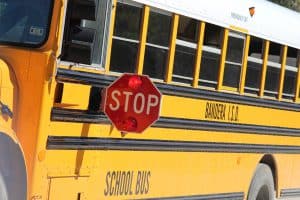By Tom Vitaglione, Senior Fellow for Health and Safety
 While the 2015 legislative session was one of the longest in memory, several important bills were left hanging for final consideration in the current session. One of these is a bill to help protect children as they get on and off school buses, Senate Bill 298.
While the 2015 legislative session was one of the longest in memory, several important bills were left hanging for final consideration in the current session. One of these is a bill to help protect children as they get on and off school buses, Senate Bill 298.
Surveys by the Department of Public Instruction indicate that stopped school buses are passed illegally more than 2300 times per school day. That projects to an astounding 414,000 illegal passes during the school year! The “miracle” that an average of just one child per year is killed by an illegal passer is attributable to safety instructions provided to bus drivers and students alike. However, we should not dismiss the cautionary reminder that the continued behavior of many drivers – whether distracted or rash – puts our children at heightened risk.
Senate Bill 298 would build on legislative attempts to enhance stopped school bus safety by allowing local school districts to contract with vendors to place cost-free cameras on school buses, and allow for the citation of illegally passing vehicles. A few buses currently have cameras, but the legal requirement is that the camera picture must identify the driver. Technologically this is difficult, resulting in very few citations and even fewer convictions. (In 2013, there were just 1408 charges, resulting in only 402 convictions.) Thus, the inherent deterrent of a camera is lost.
In 2015 the Senate approved the bill unanimously. It then easily passed the committee process in the House and was headed for final approval on the House floor when House leadership decided to hold the bill for the 2016 session now underway. It appears that the House leadership has some concerns about the citation of the vehicle, rather than the driver. These concerns need to be considered against the enhanced protection of children.
Allowing the identification of the vehicle, rather than the driver, would increase convictions exponentially, and would send a message to scofflaws that endangering our children will not be tolerated. (While the bill would allow citation of the person to whom the vehicle is registered, there is a process to exonerate the owner if they can show that they were not driving.) A similar bill was adopted in Georgia, leading quickly to increased convictions, followed thereafter by dramatically fewer illegal passes.
The consideration of competing concerns is the essence of the political process. Given the experience in the Senate and the general tenor in the House, it is likely that the bill would pass at least by a 90-30 vote on the House floor. The only impediment would be House leadership not allowing the bill to come to a vote. It’s hard to imagine why the House leadership would not want their members to be able to give a vote of final approval on such an important and popular bill.
North Carolina currently uses cameras to identify cars, not drivers, on its toll roads. While people don’t enjoy paying tolls, it’s understood that paying for the road is important. It’s even more important to protect children who are simply getting on and off of stopped school buses. The House should follow the example of Georgia and pass this bill without further delay. If they don’t, and another child is hit by a passing car, it will be very difficult to explain the lack of action.
